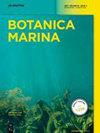Inconsistency between morphological diversity and genetic structuring: proposal for one species of Undaria in Japan
IF 1.4
4区 生物学
Q2 MARINE & FRESHWATER BIOLOGY
引用次数: 0
Abstract
Abstract Genetic structure analyses have yielded some examples of inconsistencies between genetic and morphological information. Here, eleven nuclear microsatellite markers and mitochondrial haplotypes were used to examine the genetic structure and gene flow among Japanese Undaria pinnatifida populations and the congeneric species U. undarioides and U. peterseniana. Undaria pinnatifida was subdivided into four “Groups” of populations based on Bayesian clustering analysis, Neighbor-net analysis and Principal coordinate analysis (PCoA). Undaria undarioides samples formed a unique Group. In contrast, U. peterseniana samples either grouped with a mixture of U. pinnatifida and U. undarioides clusters or were included within one of the U. pinnatifida clusters. More significantly, Groups of populations shared alleles with geographically adjacent Groups even between different morphospecies. No clear differences between the inter-and intra-specific genetic divergence were observed in either nuclear or mitochondrial markers. As a result, U. undarioides and U. peterseniana were synonymized with U. pinnatifida. Isolation-by-distance suggested the significance of geographical isolation for maintaining the observed divergence.形态多样性与遗传结构的不一致性——日本裙带菜属一个种的建议
摘要遗传结构分析已经产生了一些遗传和形态信息不一致的例子。本文利用11个核微卫星标记和线粒体单倍型对日本裙带菜种群与裙带菜和裙带菜同源种的遗传结构和基因流进行了研究。基于贝叶斯聚类分析、邻居网络分析和主坐标分析,将裙带菜细分为四个种群。裙带菜样品组成了一个独特的类群。与此相反,彼得森纳U.peterseniana的样本要么被归为羽状半裂U.和裙带菜U.undarioides集群的混合物,要么被包括在其中一个羽状半裂U.S.集群中。更重要的是,种群群与地理上相邻的种群共享等位基因,甚至在不同形态物种之间也是如此。在细胞核或线粒体标记中,没有观察到特异性间和特异性内遗传差异之间的明显差异。因此,undarioides和U.peterseniana被同义为U.羽状半裂。距离隔离表明了地理隔离对维持观测到的差异的重要性。
本文章由计算机程序翻译,如有差异,请以英文原文为准。
求助全文
约1分钟内获得全文
求助全文
来源期刊

Botanica Marina
生物-海洋与淡水生物学
CiteScore
4.10
自引率
4.50%
发文量
43
期刊介绍:
Botanica Marina publishes high-quality contributions from all of the disciplines of marine botany at all levels of biological organisation from subcellular to ecosystem: chemistry and applications, genomics, physiology and ecology, phylogeny and biogeography. Research involving global or interdisciplinary interest is especially welcome. Applied science papers are appreciated, particularly when they illustrate the application of emerging conceptual issues or promote developing technologies. The journal invites state-of-the art reviews dealing with recent developments in marine botany.
 求助内容:
求助内容: 应助结果提醒方式:
应助结果提醒方式:


